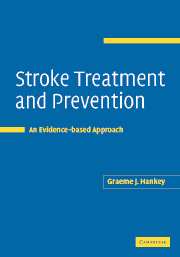Book contents
- Frontmatter
- Contents
- Preface
- 1 The size of the problem of stroke
- 2 Understanding evidence
- 3 Organised acute stroke care
- 4 General supportive acute stroke care
- 5 Reperfusion of ischaemic brain by thrombolysis
- 6 Augmentation of cerebral blood flow: fibrinogen-depleting agents, haemodilution and pentoxifylline
- 7 Neuroprotection
- 8 Treatment of brain oedema
- 9 Anticoagulation
- 10 Antiplatelet therapy
- 11 Carotid artery revascularisation
- 12 Lowering blood pressure
- 13 Lowering blood cholesterol concentrations
- 14 Modification of other vascular risk factors and lifestyle
- 15 Antithrombotic therapy for preventing recurrent cardiogenic embolism
- 16 Arterial dissection and arteritis
- 17 Treatment of intracerebral haemorrhage
- 18 Treatment of subarachnoid haemorrhage
- References
- Index
4 - General supportive acute stroke care
Published online by Cambridge University Press: 23 December 2009
- Frontmatter
- Contents
- Preface
- 1 The size of the problem of stroke
- 2 Understanding evidence
- 3 Organised acute stroke care
- 4 General supportive acute stroke care
- 5 Reperfusion of ischaemic brain by thrombolysis
- 6 Augmentation of cerebral blood flow: fibrinogen-depleting agents, haemodilution and pentoxifylline
- 7 Neuroprotection
- 8 Treatment of brain oedema
- 9 Anticoagulation
- 10 Antiplatelet therapy
- 11 Carotid artery revascularisation
- 12 Lowering blood pressure
- 13 Lowering blood cholesterol concentrations
- 14 Modification of other vascular risk factors and lifestyle
- 15 Antithrombotic therapy for preventing recurrent cardiogenic embolism
- 16 Arterial dissection and arteritis
- 17 Treatment of intracerebral haemorrhage
- 18 Treatment of subarachnoid haemorrhage
- References
- Index
Summary
As discussed in Chapter 3, there is some preliminary evidence that part of the effectiveness of organised care in a stroke unit can be attributed to general supportive stroke care, which includes optimisation of physiological homoeostasis (i.e. keeping physiological variables within ‘normal’ limits), and early anticipation and prevention of complications of stroke (Langhorne et al., 2000; Evans et al., 2001). Associations between abnormal measurements of physiological parameters (e.g. blood pressure (BP), temperature, blood glucose) in the setting of acute stroke and poor outcomes have been reported in epidemiological studies, but it remains unknown whether interventions which aim to return the physiological measurement to normal will improve patient outcome. This is because physiological measures are only potential surrogate measures of outcome. An abnormal physiological measurement may simply indicate that the patient has developed a complication, such as fever as a result of aspiration pneumonia or venous thromboembolism (VTE), and this may not (or may) correlate with outcome. Hence, an intervention that simply aims to normalise the abnormality may not be very effective unless the underlying cause is identified and treated. Although it can be argued that large randomised-controlled trials (RCTs) are not required to establish the effectiveness of close monitoring of patients with acute stroke, a more compelling argument can be made that any invasive monitoring, or intervention aimed at preventing complications or normalising physiological measurements should be evaluated by RCTs if the intervention could have adverse effects or is costly, to establish the balance between benefit and risk.
- Type
- Chapter
- Information
- Stroke Treatment and PreventionAn Evidence-based Approach, pp. 58 - 86Publisher: Cambridge University PressPrint publication year: 2005



